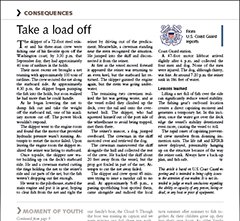Take a load off
From U.S. Coast Guard Reports
The skipper of a 72-foot steel seiner and his three-man crew were fishing one of his favorite spots off the Washington coast; by 3:30 p.m. that September day, they had approximately 40 tons of sardines in the holds.
Their most recent set brought a net teaming with approximately 100 tons of sardines. The crew secured the net along the starboard side. At approximately 4:30 p.m. the skipper began pumping the fish into the holds, but soon realized he had more than he could handle.
As he began lowering the net to dump fish out and take the weight off the starboard rail, one of his auxiliary motors cut off. The power block wouldn’t respond.
The skipper went to the engine room and found that the motor that provided hydraulic pressure wasn’t running. Attempts to restart the motor failed. Upon leaving the engine room the skipper realized the seiner was listing to starboard.
Once topside, the skipper saw water building up on the deck’s starboard side. He and a crewman started cutting the rings holding the net to the seiner’s side and cut parts of the net, but the fish weren’t dropping out fast enough.
He went to the pilothouse, started the main engine and put it in gear, hoping to clear fish from the net and right the seiner by driving out of the predicament. Meanwhile, a crewman standing near the stern recognized the situation. He jumped into the skiff and disconnected it from the seiner.
At first as the vessel moved forward it appeared the seiner was returning to an even keel, but the starboard list returned. The skipper gunned the engine again, but the stern was going underwater.
The remaining two crewmen realized the list was getting worse, and as the vessel rolled they climbed up the deck, over the rail and onto the overturned hull. The skipper, who had squeezed himself out of the port side of the wheelhouse to avoid being trapped, met them there.
The seiner’s mascot, a dog, jumped overboard. The crewman in the skiff motored over and retrieved the dog.
The crewman maneuvered the skiff alongside the hull and collected the rest of the crew. He backed the skiff about 20 feet away from the vessel, but the prop got fouled in part of the net. Attempts to cut the net away failed.
The skipper and crew spent 45 minutes trying to issue a mayday call to no avail. At approximately 5:45 p.m., a passing sportfishing boat spotted them, came alongside and radioed the local Coast Guard station.
A 47-foot motor lifeboat arrived slightly after 6 p.m. and collected the four men and dog. None of the men were injured. The dog, although thirsty, was fine. At around 7:20 p.m. the seiner sank in 186 feet of water.
Lessons learned
Lifting a net full of fish over the side can significantly reduce vessel stability. The fishing gear’s outboard location creates a direct capsizing moment and generates a temporary list. In this incident, once the water got over the deck edge the vessel’s stability deteriorated even more, causing the vessel to roll.
The rapid onset of capsizing prevented crew members from donning immersion suits. The life raft and EPIRB never deployed, presumably hanging up on the structure because of the way the seiner sank. Always have a back-up plan, and fish safe.
This article is based on U.S. Coast Guard reporting and is intended to bring safety issues to the attention of our readers. It is not intended to judge or reach conclusions regarding the ability or capacity of any person, living or dead, or any boat or piece of equipment.








